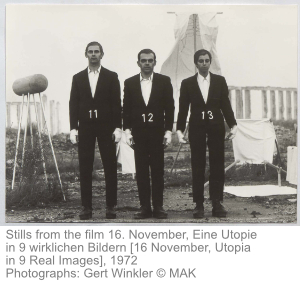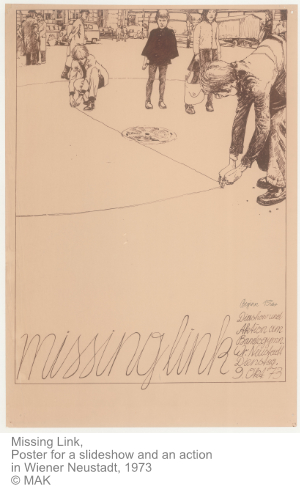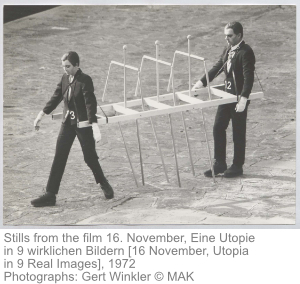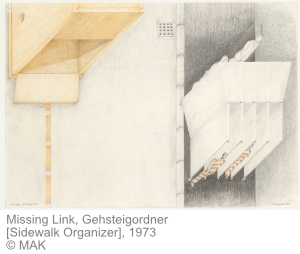 |
 |
 |
 |
 |
 |
| |
 |
|
 |
 |
 |
  |
  |
 |
 |
 |
 |
|
 |
|
 |
 |
 |
OPERE |
 |
|
 |
|
 |
 |
 |
|
|
 |
|
|
  Austria [Österreich]
Austria [Österreich]
» Vienna [Wien] |
|
|
|
|
 |
|
|
  Austria [Österreich]
Austria [Österreich]
» Furth bei Göttweig |
|
|
|
|
 |
|
|
  Austria [Österreich]
Austria [Österreich]
» Zurndorf |
|
|
 |
 |
 |
 |
MOSTRE |
 |
|
|
 |
|
 |
 |
 |
|
|
 |
Missing Link. Strategies of a Viennese Architecture Group (1970–1980), Vienna [Wien], Austria [Österreich], MAK Museum für angewandte Kunst / Museum of Applied Arts, 11 may / 2 october 2022
 Founded in 1970 by Angela Hareiter, Otto Kapfinger, and Adolf Krischanitz, the architecture group Missing Link was one of the most important phenomena to emerge on Austria’s avant-garde art and architecture scene in the 1970s. With their boundary-breaking and interdisciplinary projects, they looked for the missing links between people, architecture, urbanism, art, and social fabric and enriched architecture’s repertoire with experimental concepts. In recent years it has been possible to enrich the group’s “premature estate”—acquired by the MAK in 2014—with further acquisitions and donations. With the exhibition MISSING LINK: Strategies of a Viennese Architecture Group (1970–1980) and the accompanying catalog, the architecture group’s extensive oeuvre is being reviewed in full for the first time. Founded in 1970 by Angela Hareiter, Otto Kapfinger, and Adolf Krischanitz, the architecture group Missing Link was one of the most important phenomena to emerge on Austria’s avant-garde art and architecture scene in the 1970s. With their boundary-breaking and interdisciplinary projects, they looked for the missing links between people, architecture, urbanism, art, and social fabric and enriched architecture’s repertoire with experimental concepts. In recent years it has been possible to enrich the group’s “premature estate”—acquired by the MAK in 2014—with further acquisitions and donations. With the exhibition MISSING LINK: Strategies of a Viennese Architecture Group (1970–1980) and the accompanying catalog, the architecture group’s extensive oeuvre is being reviewed in full for the first time.
 Hareiter, Kapfinger, and Krischanitz met at the technical university (then the Technische Hochschule, now the Technische Universität) in Vienna and joined forces as Missing Link with the aim of reimagining the scope of architecture, divorced from specific commissions and academic dogmas. During the decade of its existence, the group produced an extremely multifaceted and at the time highly respected body of work comprising urban sociology studies, actions, and experimental telefilms alongside artistic installations, objects, paintings, drawings, and posters. Arranged thematically, the MAK exhibition covers the group’s entire oeuvre. Hareiter, Kapfinger, and Krischanitz met at the technical university (then the Technische Hochschule, now the Technische Universität) in Vienna and joined forces as Missing Link with the aim of reimagining the scope of architecture, divorced from specific commissions and academic dogmas. During the decade of its existence, the group produced an extremely multifaceted and at the time highly respected body of work comprising urban sociology studies, actions, and experimental telefilms alongside artistic installations, objects, paintings, drawings, and posters. Arranged thematically, the MAK exhibition covers the group’s entire oeuvre.
The show begins with the early work, which was produced while the group’s members were still students and constitutes utopian projects closely aligned with the so-called Austrian Phenomenon—the Austrian architecture avant-garde in the years from 1958 to 1973. For example, the display features Angela Hareiter’s housing modules for flexible and participative future living, which were typical of the time: Plastik explodiert [Plastic Explodes] (1965), Future House (1966/67), and Kinderwolken [Children’s Clouds] (1966/67). Works in the exhibition by Adolf Krischanitz include Swimtainer (1969), a model for floating housing modules.
Another focus of the show is Missing Link’s artistic actions and objects from the early 1970s. In Treffen auf dem Feld [Meeting in the Field] (1972), sociological behaviors were analyzed using the simplest equipment and props. This project led to a film produced later that same year for the Austrian public service broadcaster ORF called 16. November: Eine Utopie in 9 wirklichen Bildern [16 November: A Utopia in 9 Real Pictures]. Simple, at times furniture-like objects also arose during this creative period, such as Betonbrecher [Concrete Breaker] and Tonne [Barrel/Tub] (both 1971), which serve as concepts with which to explore Brutalist architecture and the emerging oil crisis.
Media analyses and research projects are another important aspect of Missing Link’s oeuvre. Projects like Via Trivialis (1973) and Via Nostalgia (1973) investigated specific urban settings in Vienna, such as the transport connection between the Westeinfahrt (major road entering to the city in the west) and the Gürtel beltway. Further unpublished essays written by Missing Link in the fields of urban sociology and media criticism will be on display in the MAK exhibition in the form of original typescripts.
 The group’s extensive drawing and painting activities are characterized by often mysterious subjects (fragments of airplanes, submarines, and zeppelins), which can be interpreted in part as a reflection on World War II or the Vietnam War: they are juxtaposed with examples of popular culture like book and record covers or film posters. The group’s extensive drawing and painting activities are characterized by often mysterious subjects (fragments of airplanes, submarines, and zeppelins), which can be interpreted in part as a reflection on World War II or the Vietnam War: they are juxtaposed with examples of popular culture like book and record covers or film posters.
Soon after Angela Hareiter’s departure from the group in the mid-1970s, the so-called Wiener Studien [Viennese Studies] were created, in which Kapfinger and Krischanitz’s growing interest in built architecture became apparent. With large-format, systematic drawings, they turned their attention to distinctive features of Vienna’s architectural landscape, such as the structural typology of Red Vienna or the interiors of Viennese coffeehouses. On the basis of their investigations, they proposed among other things their own housing complex in the tradition of Vienna’s interwar municipal housing projects: an archetypal Postmodernist answer to Red Vienna, which sadly went unrealized.
The exhibition concludes with the group’s late work, including the exhibition Austrian New Wave (Institute for Architecture and Urban Studies, New York, 1980). Curated mainly by Kapfinger and Krischanitz, the show toured several American cities and provided an overview of the Austrian architecture avant-garde of the 1970s on the basis of posters. Alongside Missing Link, these posters also represented Hermann Czech, Heinz Tesar, Rob Krier, and the group IGIRIEN, among others.
 Every area of the exhibition is enhanced with context related to the form and content of the group’s work. On display are contemporary approaches by creatives and groups such as Archizoom, Haus-Rucker-Co, Coop Himmelb(l)au, Zünd-up, Walter Pichler, Hans Hollein, VALIE EXPORT, Günther Domenig and Eilfried Huth, Joseph Beuys, Günter Brus, Ettore Sottsass, Birgit Jürgenssen, and Heinz Frank, as well as historical influences including Otto Wagner, Josef Frank, the architecture of Red Vienna, and Viennese coffeehouse culture. Every area of the exhibition is enhanced with context related to the form and content of the group’s work. On display are contemporary approaches by creatives and groups such as Archizoom, Haus-Rucker-Co, Coop Himmelb(l)au, Zünd-up, Walter Pichler, Hans Hollein, VALIE EXPORT, Günther Domenig and Eilfried Huth, Joseph Beuys, Günter Brus, Ettore Sottsass, Birgit Jürgenssen, and Heinz Frank, as well as historical influences including Otto Wagner, Josef Frank, the architecture of Red Vienna, and Viennese coffeehouse culture.
Even after the dissolution of Missing Link, the members of the group remained important protagonists in the cultural and creative sector: Otto Kapfinger earned an international reputation as an academic and long-standing contributor to the daily newspaper Die Presse and is now considered the doyen of Austrian architectural criticism. Adolf Krischanitz became a self-employed architect and is known among other things for the Kunsthalle Wien – Project Space (2001/02), as well as many significant buildings in Austria and abroad; from 1991 to 1995 he was also president of the Vienna Secession. Angela Hareiter had a successful career as an art director on international film and television projects.
The exhibition is accompanied by the publication MISSING LINK: Strategies of a Viennese Architecture Group (1970–1980), MAK Studies 29, by Anna Dabernig and Sebastian Hackenschmidt, edited by Lilli Hollein and Sebastian Hackenschmidt. German/English, 332 pages with a comprehensive catalogue raisonné and numerous illustrations, most of which are published here for the first time. |
|
|
| Adolf Krischanitz. Inventur, Berlin, Architektur Galerie Berlin - Satellit, 30 june / 8 july 2017 |
|
 |
  |
 |
|
|